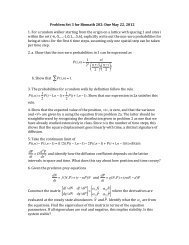342 T. ChouThe calculated gaps (such as ω(P 1 ) − ω(P 2 )) are discontinuities in ω(k x ) and areassociated with multiple Bragg scattering. Physically, oscillations with frequenciesω(P 1 )[ω(P 2 )] correspond to deformations with most <strong>of</strong> the wave nodes[antinodes]located in the low-D 1 surface rigidity regions. The origin <strong>of</strong> the first gap ω(P 2 )−ω(P 1 )is illustrated in figure 3. The solid and dotted curves represent two possible surfacedeformation waves <strong>of</strong> nearly the same wavelength λ ≃ 2π/q x ≃ 2a. Since bendingenergy is proportional to curvature squared, the mode represented by the solid curvewill have higher energy and frequency since D 2 >D 1 . Another mode <strong>of</strong> nearly thesame wavelength (dotted line) exists at a lower frequency. These two configurationscorrespond to P 2 (solid) and P 1 (dotted) respectively. Although there is an infinite series<strong>of</strong> gaps in the k x -direction, ω(0,q y ) increases indefinitely along q y . Thus, for any realω, propagating modes in some direction (with a q y component) can be found andcomplete (i.e. in all directions) band gaps do not exist. Also note that the gaps canincrease at higher frequencies, e.g. ω(P 6 ) − ω(P 5 ) >ω(P 4 )−ω(P 3 )>ω(P 2 )−ω(P 1 ).This behaviour is not seen in typical periodic acoustic or electromagnetic dispersionrelations, and is a consequence <strong>of</strong> the ∇ 2 ⊥(D(r)∇ 2 ⊥) term in the surface operatorL(r,ω) which enhances the influence <strong>of</strong> variations in D(r) at higher wavevectors.Waves with wavevectors near band gaps are standing because their group velocitiesc g = ∂ q ω(q) → 0 as a Bragg plane (q x =(0,π),q y = 0) is approached due to theinherent q ↔−qsymmetry <strong>of</strong> ω(q). The sensitivity to D 1 is also shown in greaterdetail in figure 4(a); as D 1 increases the dispersion relation develops more <strong>of</strong> anupward curvature shown in figure 4(b) indicative <strong>of</strong> the increasing bending wavecharacteristics, due to the overall increase in surface bending rigidity. The gap widthsmay also increase with decreasing surface contrast |D 1 −D 2 | (cf. dotted vs. solid curvesin figure 4(a)). This origin <strong>of</strong> this behaviour is the higher-order gradients acting onD(r) in the dynamical boundary condition (2.8), and is absent in the periodic photonic,acoustic, and electronic problems.Figure 5 shows the positions and widths <strong>of</strong> the first three band gaps (labelledl corresponding to ω(P l+1 ) − ω(P l )) as a function <strong>of</strong> depth h for filling fractionf =0.8,D 1 = 0 and D 2 =3.0. Wave motions reach a depth <strong>of</strong> ∼|k| −1 , thus deptheffects become important only when |k|h 1 such that the impenetrable bottombegins to influence the dispersion (2.9). Therefore, the higher-order band gaps (higher|k|) saturate to their h →∞limits at smaller depths.Band gaps are sensitive to both filling fraction f and D 1 . Figures 6(a) and 6(b) showthe filling fraction dependence <strong>of</strong> the first three gaps for D 2 =3.0, h = ∞, and D 1 =0and 1.0, respectively. Band gap widths are not monotonic functions <strong>of</strong> f and generallyincrease near larger values <strong>of</strong> f when D 2 >D 1 ∼0. As expected, the gap frequenciesare generally larger for smaller f when D 1 >D 2 (not shown). All gaps disappear atf = 0 and f = 1 as the interface becomes uniform. Note that for the second (andhigher) bands, the gap widths alternate and disappear for special values <strong>of</strong> f. Thisproperty is a consequence <strong>of</strong> the alternating behaviour <strong>of</strong> D(G). Higher bands havequalitatively similar behaviour but are at much higher frequencies, beyond the scale<strong>of</strong> figure 6.The variation in band gaps as a function <strong>of</strong> D 1 is also analysed. The first, second,and third gaps as functions <strong>of</strong> D 1 /D 2 (D 2 =3.0) for h = ∞ and f =0.6 and f =0.8 areplotted in figures 7(a), 7(b) and 7(c), respectively. The first gap, shown in figure 7(a)is most sensitive to variations in D 1 near D 1 = 0. The gap increases rapidly from asmall constant value as D 1 is increased until it vanishes as D 1 approaches D 2 , whenthe surface becomes uniform. At this point the dispersion relation is governed by (2.9)in all directions. Figures 7(b) and 7(c) however, show special values <strong>of</strong> D 1 ≠ D 2 where
Band structure <strong>of</strong> surface flexural–gravity waves 3432.22.12.0ω1.91.8P 21.71.6(a)5.0P 14.54.03.5ω3.0p/2(b)3p/42.52.0pFigure 4. An expanded plot <strong>of</strong> the first band gap for D 2 =3.0 and various D 1 .(a) Solid curves,D 1 =0(P 1 ,P 2 labelled as in 2); dashed curves, D 1 =0.03. The repeated zone notation is indicated.(b) Solid curves, D 1 =2.0; dashed curves, D 1 =6.0the second and higher gaps vanish, similar to the vanishing <strong>of</strong> gaps as a function <strong>of</strong>f shown in figure 6.3.2. Two-dimensional periodicityWe consider surface wave propagation through a periodic field <strong>of</strong> circular scatterersarranged in a two-dimensional lattice as shown in figure 1(b). The single scatteringanalogue has been considered in the context <strong>of</strong> wave scattering from a circular icefloe (Meylan & Squire 1996), or a circular patch <strong>of</strong> surfactant (Chou, Lucas & Stone1995). The two-dimensional dispersion relations depend in a more complicated wayon the direction <strong>of</strong> q. We show the results for square and triangular lattices, where|G(0, 1)| = |G(1, 0)| =2π/a and R 0 = a(f/π) 1/2 for square lattices, and |G(0, 1)| =|G(1, 0)| = 4π/ √ 3a and R 0 = 3 1/4 a(f/2π) 1/2 for triangular lattices. In the twodimensionalplots, we have chosen D 2 = 100.0 and D 1 = 0, corresponding to d ∼2.6 cm <strong>of</strong> ice when a = 100 cm. We arbitrarily used f =0.3 for the square lattice and




